February 23, 2014 at 2:03 pm
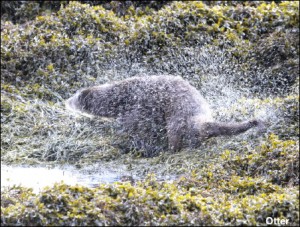
Another week on Islay and this time better weather produced more photographic opportunities.
In the Sound of Islay I caught up with a dog Otter that was fishing for more than an hour. When it finally came ashore I was ready for the shake and also managed a few shots when it rested.
On another afternoon I encountered some feeding Chough and managed some individual and group shots of our rarest member of the crow family. In the past I have obtained video of Roebucks walking through the snowdrops but did not see any in the woods this year. You will have to make do with our two Golden Retrievers instead . Click here for the photo plus other photos taken during the week.
Whilst our February visit this year has been windy and wet it has also been very mild so much so that we have watched two pair of Ravens building their nests and found a Rock Dove’s nest with one egg in. Still more surprising was the emergence of a Small Tortoiseshell butterfly on the 18th desperately searching out the mid-day sun.
On 19th February forty Black Guillemots were active in the Sound of Islay. A trip to Jura was disappointing and only produce a pair of Canada Geese, a multitude of which we can see any day on our local canal!
February 15, 2014 at 8:36 pm
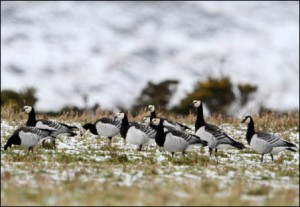
Well not exactly Snow Geese but Barnacle Geese in the snow. We have just had one of the wildest ever weeks on Islay complete with several inches of snow on one day. One of the reasons for visiting Islay in February is to see the fabulous carpets of snowdrops and we were not disappointed. Amongst the snowdrops were many fine specimens of Scarlet Elf Cup fungi.
Each day we have driven around the island and conducted all our birdwatching from the car as it was impossible to walk far in the strong winds and heavy rain. We have seen thousand of geese and flocks of up to thirty seven Chough. Merlin and Hen Harriers have been watched most days but the strong winds have grounded any Eagles! Seals and Deer have been encountered along with one Otter which disappeared from view almost as quickly as it was found. Hopefully Spring is not too far off as two Hares were seen boxing!! Despite the weather and lack of sun I have still managed to capture some photos click here to view
February 8, 2014 at 10:14 pm
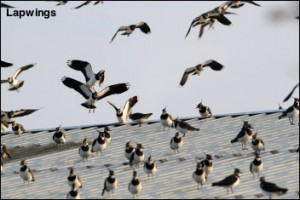
The practise of Lapwings roosting on rooftops is something that has been going on in Greater Manchester for more than twenty five years.The borough’s of Leigh, Bolton, Bury, Oldham, Stockport, Ashton and Middleton all have regular sites used by Lapwings and sometimes these are joined by Golden Plover. The reasons for the move from roosting in pastures to rooftops is not clear. Safety away from the ever increasing Fox population could be one reason with another being the benefits of underground heating that an industrial unit provides. A local industrial unit has had as many as one hundred and eighty Lapwings roosting this Winter and I have obtained flight shots as they have been coming and going. Click here.
At dawn on the 4th February we had a record of thirty four Goldfinches in the garden. Unfortunately they were on the telephone wires of the front garden and not on the food put out in the back garden! In Hopwood on the 5th I had a welcome sighting of a Woodcock which is the first I have seen for some weeks.
February 2, 2014 at 5:06 pm
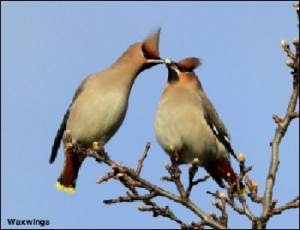
With the first morning sun for some time I could not resist the temptation to visit Blackburn to see the four Waxwings that have been present for nearly a month. All four birds were roosting in four tall trees at the rear of the car park so I waited for them to feed on the rowans surrounding the car park . The four birds comprised of a least one adult bird and two young birds from last year. What happened next was a complete surprise. One of last year’s young appeared to pluck a yellow berry still on the roost tree and pass this to the other young. This was repeated many times over a ten minute period with the receiving bird always accepting and eating the offering. When I returned home and inspected closely the photos I had taken I found that the yellow food was not a berry but a yellow Spring bud. It was not possible to identify the type of trees that were springing into life and producing the buds. The interesting fact though is that as both birds involved were born last year neither of them would have seen a Spring bud before. Click here.
The continuation of the wet weather this week has resulted in more filming of the garden Long Tailed Tits with at least a dozen feeding on a daily basis. On Hopwood some Winter Thrushes are still present and the first fungi of Spring has appeared in the form of the Scarlet Elf Cup. A Kingfiser was still present on the local canal on 1st February.
January 26, 2014 at 3:18 pm
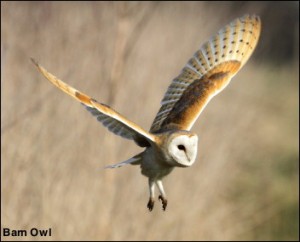
Following on from the wet Summer of 2012 and the cold Spring of 2013 we have now had more than two months of rain, much of which has fallen over night. This combination has been a disaster for Barn Owls with the recent report suggesting that there are now only 1000 pairs left breeding in Britain. This suggestion is confirmed in Greater Manchester where only five pairs bred successfully last year. The most successful of these was a pair that fledged five young on the outskirts of Rochdale. Sadly the female has just been found drowned in a horse trough so the local situation goes from bad to worse. Horse troughs are the nemesis of many British Barn Owls. Click here for Barn Owl photos.
With the inclement weather I have spent most of the week filming in the garden. The Long Tailed Tit party peeked at fourteen and during two nights two Tawny Owls were very vocal. Along the canal on the 21st a Kingfisher was fishing and is always a star bird to encounter.The most surprising event of the week was the finding of two plants of Herb Robert in full flower!!
January 20, 2014 at 10:20 pm
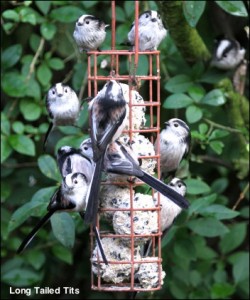
With the wet and dull weather over this last week I have spent time most days trying to film the large flock of the Long Tailed Tits that come to the fat ball feeder a couple of times each day. I finally obtained a shot where you can count ten birds together. On the 18th January we had a pair of Siskins feeding which is a very early time of the year for Siskins as the main passage through the garden is usually late March into April. The female Great Spotted Woodpecker comes daily and is featured in this week’s gallery plus some of the other birds that have visited our garden over the past twelve months. Click here.
On Hopwood on the 13th January I flushed my second Jack Snipe of the Winter. The local canal was visited by two male and one female Goosander on the 15th. Around Oldham more than fifty Redwings have now finished off the last of the berries which is a great shame as four Waxwings have just arrived in Blackburn! A visit to a local reservoir during the week produced a juvenile Black Throated Diver which, sadly, stayed too far out to be photographed.







